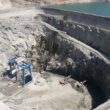Construction activities are the lifeline of human civilization. Right from the day humans evolved, we have been meticulously planning and constructing with the available resources to make our lives better. With the advancements in technology, construction has now become more vivid. Various forms of construction work help shape our world. Life would come to a standstill for us without it. However, construction activities can pose serious challenges for the environment.
These activities generate pollution, exhaust natural resources, and directly disrupt the ecosystems. Thus, the need of the hour for construction companies is to emphasize environmental conservation before implementing their construction works. Some companies like Osterman are leading the way in this aspect. Let us explore the reasons that make environmental conservation a priority for construction businesses, and how they can carry on their work without challenging the ecosystems.

Minimizing environmental impact
Ideally, the focus of construction businesses should be to embrace methods that guarantee environmental protection. It would eventually minimize the negative effects on the earth. Since construction industries are significant contributors to various environmental issues, adequate measures must be taken to reduce the carbon footprints. Turning a blind eye will increase air and water pollution, destruction of habitats, and increase the ill effects of greenhouse gases. Consequently, the earth would become unsuitable for humans to lead a healthy life. Thankfully, eco-friendly practices are now out, and they can efficiently negate the adverse effects. Thus, we can safeguard our planet for future generations.

Regulatory compliance
Environmentalists for long have voiced their concerns over the harmful effects of unplanned construction. Thus, countries all over the world have now introduced environmental regulations and standards. Construction companies must adhere to these rules else they can attract severe legal consequences. Moreover, people involved in the construction industry should be aware of the harmful effects and thus prioritize environmental conservation with the help of the available tools. It will not only help them avoid legal hassles, they will make a significant contribution to making the world a better place to live.
Environmental conservation leads to cost savings
Of course, the initial investments for ensuring sustainable construction practices require investments. However, in the long run, it can lead to significant cost savings. Some of the practices like energy-efficient designs, recycling of wastes, innovative construction methods, and the use of environmental monitors in the long run can reduce operating and maintenance costs to a great extent. To encourage such practices, many governments and local regulatory authorities are now offering incentives for such green construction projects. Ultimately, it can further help the construction businesses in cost savings.
Spreading the message of eco-friendliness
As mentioned earlier, everyone is now conscious of the environmental impacts of construction activities. Thus, consumers and businesses prefer sustainable products and services. Therefore, construction businesses that are quick to act, and take up environmentally friendly practices can expect more clients. Regardless of whether the construction companies require practicing hazardous works like drilling and blasting, such eco-friendly solutions can help them accomplish projects without causing damage to the environment. A company that earns the tag of eco-friendly practices will naturally improve its brand image and attract more prospects.

Protecting the health of workers
The workers involved in any construction projects bear the brunt of the negative impacts of construction activities. Since they are the ones who engage in operations like drilling, blasting, or even explosions, they might suffer serious injuries and other health issues. When construction businesses embrace eco-friendly practices like installing environmental monitors and switching to non-explosive agents, they can significantly contribute to protecting the health of their staff. Then again, a company that builds such a good rapport with its employees will help increase its brand value and attract more projects in the long run.
Minimizing the wastage of vegetation
Earlier, construction companies for the sake of their project would flatten the entire construction site leading to the destruction of vegetation. Such practices are now avoided by responsible businesses. Before commencing their operations, a thorough assessment of the site would let them understand if vegetation exists at that place. They can implement measures to protect such areas and reduce the damage. Such practices can help save the trees and protect natural vegetation.
Reducing the dependency on natural resources
Like Us on Facebook!
Usually, any construction business depends heavily on non-renewable resources for carrying out their activities. Some of the common names include wood, water, and minerals. However, using each one of those depletes the natural reserves of the earth. Therefore, construction businesses now practice eco-friendly activities like recycling and limiting their dependency on such natural resources. Such sustainable practices can not only safeguard the environment, it also let construction businesses reduce their carbon footprints significantly.
Subscribe Us on YouTube!

Finding newer and better ways
As technologies related to environmental conservation improve, construction industries can find new and better ways for sustainable construction methods. For example, they can consult environmentalists and ask them to make comprehensive assessments before starting any construction project. Furthermore, they must keep a tab on the latest tools and devices that would help them in the development of a greener and more sustainable construction.
Efficient planning can help construction projects to reduce waste after the project is over. As discussed earlier, recycling of waste materials is the best solution for reducing the harm caused to the environment. All the practices mentioned above will let them achieve their targets without causing environmental damage.



















